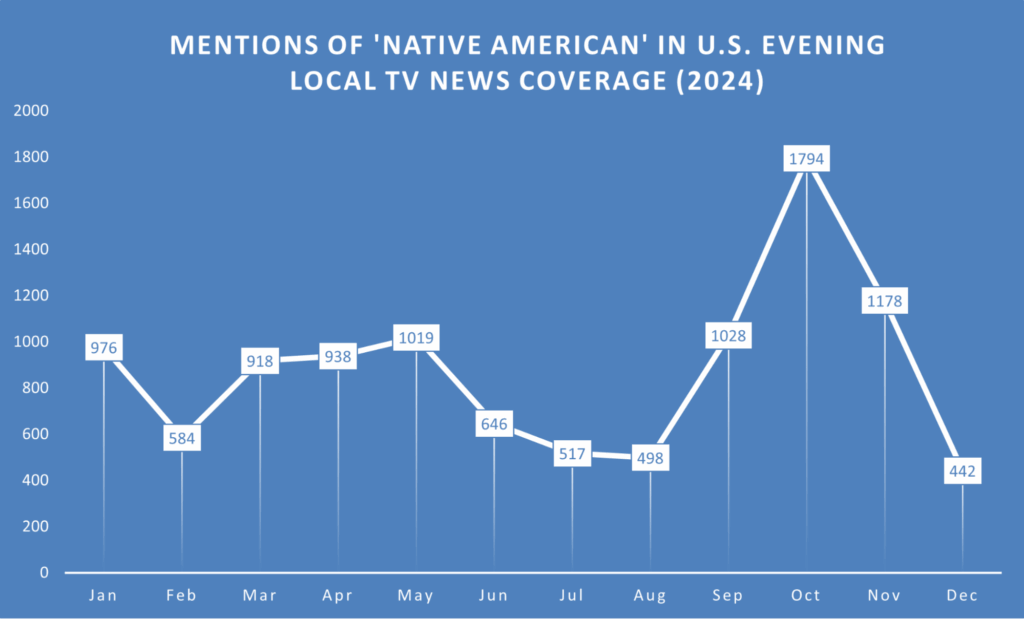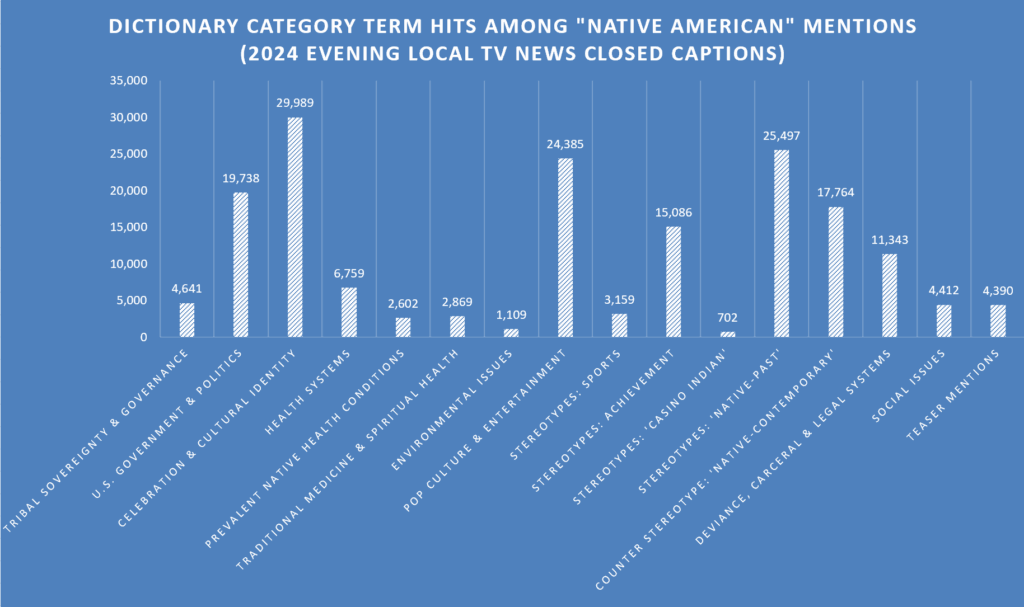How do U.S. Media Cover Native American People? Preliminary Findings from an Analysis of 2024 U.S. Local TV News
By Quin Mudry-Nelson
When over 5,500 non-Native survey respondents were asked to recall depictions of Native Americans they had seen or heard about in film and television, they had little to say. In other words, researchers found that both well-known living and deceased Native American people escape the general public’s memory.
What are the consequences of such findings for Native American people—what does it mean when the society around them has little recollection of their continued existence? Analysis of representation in the news media is an important step in answering this critical question. Local TV news is an essential media type to explore for Native American depictions, given it is relatively highly trusted and covers issues in a local community context. Given the prevalence of Native residents varies across geographic areas, non-Natives may see different depictions of Native Americans depending on where they live.
In our 2024 report synthesizing research questions from health communicators, some participants asked why reporting on minoritized groups such as Native Americans is rare, and when they are in the news, the topics are often negative. With this question as our motivation, our team initiated the Native American Communication Project: an exploratory study that aims to investigate trends and patterns of attention to Native Americans in local TV news to understand where and when Native people are visible in local TV news, and what topics are discussed alongside them.
Our pilot study analyzed closed captions snippets from evening local TV news broadcasts from ABC, NBC, CBS, and Fox affiliated stations across the United States that aired between 01/01/2024 and 12/31/2024. We focused on evening local TV news for the pilot, knowing that this form of media is still a broadly trusted and frequently viewed source of news and information.
Our preliminary results revealed three important findings:
1) Native Americans receive the most news coverage in October and November. We attribute this to the U.S. federally-recognized holiday of Indigenous People’s Day which occurs on the second Monday of October, as well as November being American Indian Heritage Month.

2) More attention is given to people in the Western region of the country clustered around large and well-known Native American tribal reservations while there is minimal coverage in the Midwest, Northeast, and Southern regions of the country, even near tribal lands.
MENTIONS OF NATIVE AMERICAN BY MEDIA MARKET IN U.S. EVENING LOCAL TV NEWS COVERAGE (2024)

3) The most frequently co-occurring topic mentioned alongside Native Americans was Celebrations & Cultural Identity, which included words referencing positive-leaning celebrations and cultural depictions such as “powwow”, “ceremony”, “community”, “language”, and “tradition”. The second most mentioned topic was Pop Culture & Entertainment, which included any mentions of film, TV, art, cuisine, and fashion. Thirdly, we found Native-past keywords (such as “history”, “museum”, “artifact”, “old”, “ancestor”, and “primitive”), were more common than Native-contemporary keywords (such as “today”, “present”, “progress”, “plan”, and “modern”). This finding demonstrates how Native American portrayals in the news center narratives about the past, rather than news stories grounding Native communities in the present and sharing progress or plans for the future.
Our pilot results reflect the beginning of a much larger ongoing project investigating representation of Native American people in U.S. media and the consequences of that representation. We look forward to sharing more about our findings in future posts.

Special thanks to the members of the Native American Communication project team: Sarah Gollust, Neil Lewis Jr, Erika Franklin Fowler, Kari Waters, and Breeze Floyd for their help and guidance on this work.
Read more related work from the COMM team:
- An Update on Attention to Local TV News Racism & Counter-messaging
- Strategies and Challenges for Public Health Communicators
- How declarations of racism as a public health crisis were geospatially distributed across the U.S.
- How local TV news covered controversy surrounding masks during the COVID-19 pandemic
This post was funded by the Robert Wood Johnson Foundation (Grant no. 79754). The views expressed here do not necessarily reflect the views of the foundation.